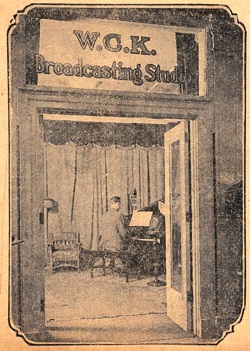Radio Articles
Broadcasting Studio Visited
Have you ever wondered as to the personality of WCK, when her voice, smooth and velvety as honey, comes “out of nowhere into the here” of your living room, club room or office, or wherever your radio set may be?
 The radio station, WCK, Stix Baer & Fuller of St. Louis, is ever a popular one in Divernon (Illinois) and last Tuesday through the courtesy of Alva B. Jefferis, the editor had the privilege of visiting Station WCK while broadcasting was in progress at the noon hour, and meeting Miss Hatfield, the announcer, whose calm pleasant tones are identified by thousands of invisible listeners as “WCK.”
The radio station, WCK, Stix Baer & Fuller of St. Louis, is ever a popular one in Divernon (Illinois) and last Tuesday through the courtesy of Alva B. Jefferis, the editor had the privilege of visiting Station WCK while broadcasting was in progress at the noon hour, and meeting Miss Hatfield, the announcer, whose calm pleasant tones are identified by thousands of invisible listeners as “WCK.”
She’s just a slip of a girl, with an unconscious poise which makes her a perfect mistress of the broadcasting studio of Stix Baer & Fuller.
Opening the glass doors and pushing aside the heavy blue rep curtains with which the studio is enclosed, and rendered more sound proof, Miss Hatfield divested herself of coat and hat, greeted the performers who were to give the noon program, and conferred tactfully with would-be radio artists. Also some shoppers who had wandered into the studio, were gently escorted into the corridor and the glass doors closed upon them. Then the brief “If you are ready?” to Mr. Jefferis who was to open the program with a group of saxophone melodies, Miss Hatfield touched a button which connected that blue draped studio with the universe, struck a gong, approached the microphone, and with a pleasant “Hello folks” to the world in general the broadcasting of the noon program was on.
Except for the little microphone on its pedestal, there was nothing to betray the onlooker that Mr. Jefferis was playing to the world at large. The studio, aside from its drapings from ceiling to floor with blue rep, contained a grand piano, a few comfortable chairs, and a small table for Miss Hatfield’s convenience. The microphone which looked for all the world like a seven-inch motometer standing on a pedestal, was about six feet from the musicians, and Miss Hatfield approached it not too intimately when speaking in a normal tone of voice. While giving the stock markets and the news of the day, Miss Hatfield was seated. For the announcement of the musical numbers, she sauntered over and simply leaned toward the instrument for the few sentences she wished to say.
From the broadcasting studio on the fourth floor, the program is telephoned to the transmitting set on the twelfth floor, from which point it goes out to the world in general. Our party was guided to the twelfth floor, and there crowded into a corner by various tanks, levers and machinery pertaining to the elevator system, was the wonderful instrument which connects you and me with all the desirable things which Stix Baer and Fuller see fit to broadcast every day. I wish I could describe it to you, but I can’t. One doesn’t try to explain a miracle. But I can tell the feminine readers just what Miss Hatfield wore! She had on a long-sleeved dress of black velvet with a “fence-row” band of dull black on the slightly full skirt, a string of pearls around her neck and a bar pin at the throat. She wore beige hose with suede shoes of a darker shade, with buttoned straps and military heels, and her hair was bobbed – rather long, and marcelled.
Broadcasting is an old story to Mr. Jefferis. He and his pianist mulled over a pile of music on the piano, choosing this, rejecting that, and finally pulled out something they had never seen, and opened the program with that.
Mr. Jefferis signed a contract that day to play from WCK from 3 to 9 o’clock on Monday evenings, from March 3 to May 1. The performance will be broadcasted as a Freed Elsemann program, yet Mr. Jefferis, with (garbled) members of his orchestra whom he may select, will direct the music.
(Originally published in the Divernon (Illinois) News 2/27/1925)
 “This is Station KSD, the Saint Louis Post-Dispatch. We are about to present our first musical program for your enjoyment.”
“This is Station KSD, the Saint Louis Post-Dispatch. We are about to present our first musical program for your enjoyment.”